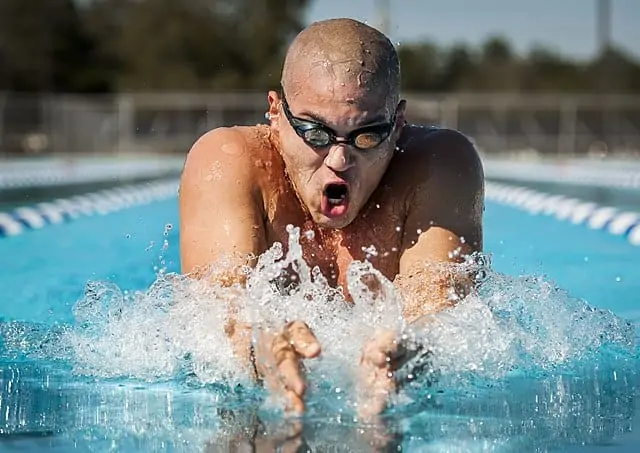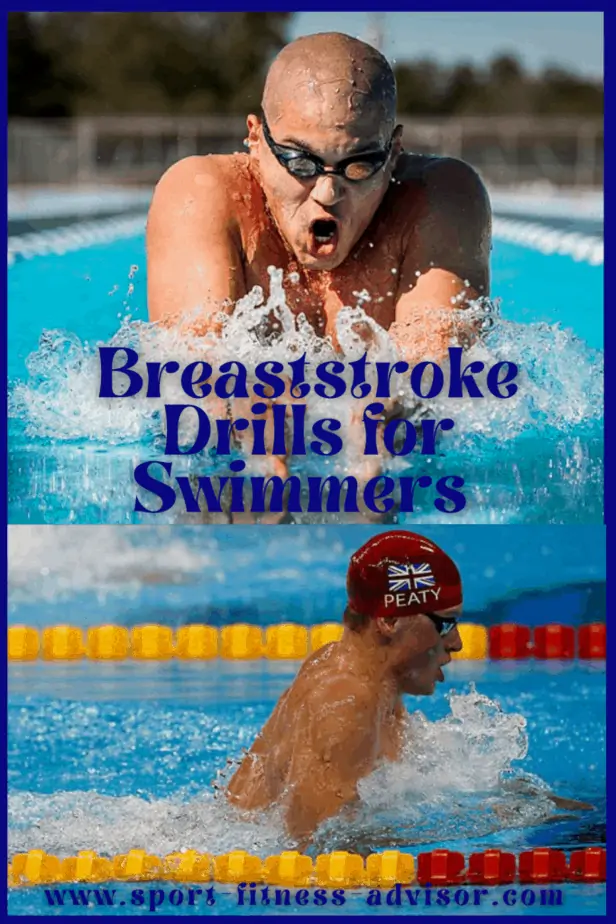Breaststroke may look easy to swim, but it is the most difficult stroke to master. The slowest of the four strokes, breaststroke is all about timing and once that has been mastered, it becomes an elegant and powerful stroke that is beautiful to both swim and watch.
It may be the slowest of the four strokes but uses an incredible amount of energy to swim – approximately 500 kcal/h for women and 700 kcal/h for men, so it is important to swim breaststroke with the correct technique.
The most difficult aspects of breaststroke to master are the timing, the correct body position, and getting the most efficient drag profile in the water. The best way to master these aspects is by including breaststroke drills in your training program.
Breaststroke is all about timing. Adam Peaty in the 100m Breaststroke Final by Fernando Frazão/Agência Brasil / WikiCommons / CC BY 3.0 br
The Importance of Timing in Breaststroke
Breaststroke is the least efficient of the four swimming strokes due to large frontal resistance in the water created by a wide kick and arm pull, and the overall body position. The most efficient part of the stroke is the glide phase after the kick and the arm recovery when the body is in a streamlined position.
The glide is formed when the legs and feet come together after the kick and the arms are fully extended with the hands held together. The body is in a smooth, streamlined position and can glide effortlessly through the water.
If the timing in breaststroke is incorrect, the glide becomes compromised and creates a greater frontal resistance, slowing the stroke down enormously. If the kick is too late or the arm pulls too soon, the timing of the stroke is out and causes a disjointed and inefficient swimming stroke. Thus, the timing of the stroke is essential in helping to produce a smooth and easy swimming stroke.
Breaststroke drills are the key to mastering these vital elements of the stroke. They also help to clean up the breaststroke pull and hit race pace tempo in both training and racing. The correct breaststroke drills can help you over-emphasize the weakest part of your stroke so that you can improve your overall swimming.
Breaststroke drills are the key to mastering these vital elements of the stroke.
What is a Swimming Drill?
A swimming drill is a stroke-specific exercise that has been designed to focus on one or two particular aspects of that stroke. Drills are done to change or improve a part of a stroke such as breathing, arm position, kicking, and rotation. Improvements in stroke technique can have a major impact on how efficiently you move through the water, so drills are a vital part of your swim training session.
Tips for Getting the Best Out of Your Breaststroke Swimming Drills
Here are some top tips for getting the best out of your breaststroke drill in the pool.
Balance Drills with Regular Swimming
Balance breaststroke drills with regular swimming to transfer what you are working on into your regular stroke. For example, alternate between swimming and drills for each length – 25m drill, 25m swim. Drills are only effective if they are being incorporated into your stroke to help you swim better.
Go Slow!
Drills are designed to improve technique and skill so take your time when doing drills and concentrate on each part of the exercise. Drills are supposed to be technical so take enough rest to do them properly.
Get Feedback from a Coach
Getting feedback is vital to ensure you are doing the drills correctly. If you don’t swim with a coach, video yourself doing the drill to see if you are doing it correctly.
The technique is at the core of swimming.
Breaststroke Drills for Swimmers
Swimming isn’t just about speed – technique is at the core of swimming all four strokes correctly and efficiently. Working on technique regularly can drastically improve your efficiency in the water, as well as your overall speed and performance.
1. Breaststroke Arms with Butterfly Kick
One of the issues many breaststroke swimmers struggle with is maintaining a steady speed in the water. This is caused by not recovering the arms fast enough, creating a jerky, stop-start movement while swimming.
The breaststroke-arms-with-fly-kick drill is a great option for improving arm recovery speed and maintaining a rhythmic, diving motion into the catch. Swim 25m of regular breaststroke and 25m of breaststroke arms with flutter kick to incorporate the faster arm recovery speed into your regular stroke.
https://www.youtube.com/watch?v=wHwq8uiz3rE&feature=emb_logo
2. Windshield Wiper Breaststroke Drill
The Windshield Wiper Breaststroke Drill is designed to improve the breaststroke pull. It is the first drill in a three-part drill sequence that focuses on the out-sweep part of the arm pulling motion.
Keep a straight and streamlined body position in the water with the feet up by tightening the body’s back core muscles. Sweep the forearms outwards with straight elbows and float the forearms back together. Keep your feet together and don’t kick so you can concentrate on the arm movement only.
If you struggle to maintain the correct body position in the water, use a pull buoy for added buoyancy and a swimming snorkel to help keep your hips high and spine straight.
Swim 25m of regular breaststroke and 25m of the Windshield Wiper Breaststroke Drill to work on the out-sweep part of the arm pulling motion.
https://www.youtube.com/watch?v=7UrISlv_O-c
3. In-Sweep Drill Breaststroke Drill
The In-Sweep Breaststroke Drill is a sculling drill that also works on a quicker arm recovery and helps to improve timing and flow in the stroke. This is a great drill for shortening the gap in momentum that occurs when the arm recovery is too slow.
Start with your hand and in a Y position with your hands just outside the elbows. Only execute the catch phase of the pull making sure that your elbows stay up and reach the position where the pulling motion would normally. Slide the hands back out front and repeat.
Alternate this drill with regular breaststroke by performing three cycles of the sculling motion followed by three full stroke cycles.
If you struggle to maintain the correct body position in the water, use a pull buoy for added buoyancy and a swimming snorkel to help keep your hips high and spine straight.
https://www.youtube.com/watch?v=bxl3_MAkOzo
4. Speed Bump Breaststroke Kick Drill
The Speed Bump Kick Drill is designed to focus on the thrust or surge into the arm recovery. The goal of this drill is to feel the hips thrusting forward as the heels come up to the gluteus maximus. The drill is performed on your front with your hands dangling at your sides next to your hips.
Bring the heels up to the knuckles and kick powerfully, as you would if you were swimming over a “speed bump” in the water. Swim half a length with your arms at your side, then complete the length with your hands and arms in a glide position while still maintaining the hip thrust motion.
https://www.youtube.com/watch?v=M4yhyBvLwTc
5. One-Up, One-Down Breaststroke Drill
The One-Up, One-Down Breaststroke Drill is a popular breaststroke drill for helping swimmers “hit your line” as they swim up and down the length of the pool and ultimately swim faster.
The drill is as easy as it sounds. Perform one regular stroke above the water, followed by one stroke under the water. The downstrokes must be done with the regular arm motion, not as pull-outs. The drill can be done in several variations as in two regular strokes above the water, followed by two strokes under the water, 3/3 and 4/4, etc.
Use flip-turns instead of open turns and intervals on the pace clock to make the drill more challenging.
https://www.youtube.com/watch?v=1EV9lXORmmo
6. One-Arm, One-Leg Breaststroke Drill
The One-Arm, One-leg Breaststroke Drill is designed for advanced swimmers to hit race pace tempo. Aimed at more experienced swimmers, the drill focuses on developing and sustaining a high-end race tempo for competitive swimmers looking to fine-tune their race-day performance.
Swim normal breaststroke and grab one leg with the opposite arm in a long quad stretch. Release the leg at the 15m mark and continue swimming with the same tempo held during the drill. This drill will feel awkward for the first few times you do it, but once mastered you will feel the difference in the tempo.
Remember that the goal of this breaststroke drill is a quick arm and kick tempo, which will carry over into your full swimming.
Less experienced swimmers can do the drill without grabbing the leg and simply swimming with opposite arms and legs as in the video below.
https://www.youtube.com/watch?v=DTsJjzlyU3g
7. Head-Above-the-Water Breaststroke Drill
The Head-Above-the-Water Breaststroke Drill is designed to increase the arm rate of the stroke, which will create faster momentum to keep the upper body raised in the water. It’s a simple drill -all you need to do is swim regular breaststroke with your head out of the water and a very fast arm rate.
Put fins on and do this drill with a super-fast butterfly or freestyle kick, while keeping your head out of the water.
https://www.youtube.com/watch?v=X2EQq-tP4yc
8. Sculling Breaststroke Drill
Sculling is an age-old swimming drill that works on the weaker parts of all four strokes. There are endless varieties of sculling drills, all of which focus on getting a better feel for the water, working on catching the water, and strengthening weaker aspects of a stroke.
Sculling is also a great drill for body positioning in the water and maintaining a streamlined position while swimming. You can use a pull-buoy and ankle elastics for added arm work and better positioning.
https://www.youtube.com/watch?v=v-l6g79sAks
9. Two Kicks, One Pull Breaststroke Drill
This is a great drill that focuses on improving the streamlined position and the timing of the kick. Kicking twice with one stroke will make you focus on the position of your body in the water, as well as make you more aware of your leg movements. It also works towards kicking with maximum propulsion and recovering your legs with minimal drag.
To perform this drill correctly, swim breaststroke and kick your legs twice for every arm stroke. End the first kick before the end of the arm stroke, while the second kick needs to come when your body is fully extended before starting the arm stroke.
Kicking twice lets you spend more time in the horizontal streamline position with your arms extended forward. Don’t forget to focus on the out-sweep, catch, in-sweep, and recovery forward of the arms, as well as the kick.
Get the most out of this drill by doing at least six to eight lengths in a set. Try one kick and two pulls as a complementary drill.
https://www.youtube.com/watch?v=G7buaQ6mokk
10. Single Arm Breaststroke Drill
The Single Arm Breaststroke Drill is designed to increase the efficiency and strength of the breaststroke pull, as well as minimize resistance. It may feel awkward and ineffective at first, but after repeated practice, it will also help with the correct timing of the stroke.
To perform the drill, alternate between a right arm pull, a left-arm pull, and a full normal pull for a full length (25m or 50m), using a full breaststroke kick following each pull. Keep the opposite arm extended in front while completing the single-arm pulls.
Focus on catching the water and grabbing as much as possible through the in-sweep of the pull to feel the forward thrust in the initial phase of the stroke. The middle and recovery phase of the pull should be as fast as possible, minimizing any pause in the stroke. Be aware of the timing of your pull and whether it feels more effective and efficient.
https://www.youtube.com/watch?v=NvbPLoF2FEc
Final Thought
While breaststroke is a very technical stroke and requires a lot of work to get the timing, the correct body position, and the most efficient drag profile in the water right, keep this fantastic quote from former Rutgers coach, Chuck Warner in mind:
“Sometimes the best way to work on breaststroke is to stop working on breaststroke.”
Focus on other strokes in the pool and trust your body – it’ll tell you when you need to take a break and when it’s time to return.
Happy swimming!

Mia Russell is currently the head swim coach at Aquasharks Swimming Academy in South Africa. She has worked as the head swim guide at SwimQuest Open Water Swimming Holidays in London and was previously a Swim Coach at Cybersmart Aquatics. She has a AIDA International Level 3 Freediving Certification, PADI Open Water Advanced Certificate, SSI Level 1 Free Diver Certificate and RYA Beach Lifeguard Certificate.




